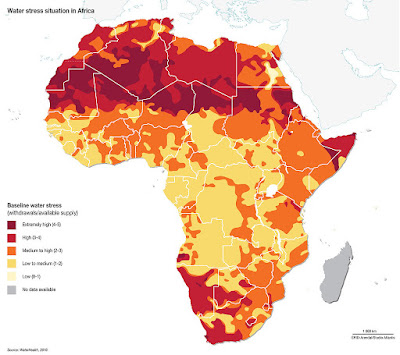Water, food and Africa. A remaining topic in the media, often documented in a very one-sided way. With this blog, I want to take the opportunity to talk about misconceptions and facts in a more informed way. Water and food in Africa is not all about famines, scarcity and poverty, but about inventions, politics and environmental discussions. It is about tradition and modernisation, capitalism and subsistence, but most importantly about the very basic needs of every human being. This blog will not deny the water scarcity many African countries are facing, but it will try to get to the bottom of the general topic of water availability and distribution.
My knowledge about water and food in Africa is limited - based on the experiences I made in Ghana myself and various Geography lectures. Therefore, I want to begin this blog with the basics of famines and a general overview of water resources on the African continent. The following map is to visualize the water stress situation in Africa at the moment.
 |
| Figure 1. Water stress situation in Africa. (Source) |
Water scarcity can be defined as “the gap between the freshwater resource available and the demand under prevailing conditions”. 54% of countries in Africa are water scarce or severely water stressed, especially in the Northern and Southern Africa. 20% of the population lived under water scarcity conditions in 2016. These numbers will presumably rise in the future due to a growing population, climate changes and the use of non-renewable water resources. But not only the physical lack of water causes water scarcity. Water sufficiency also depends on infrastructural capacity (such as pipes, wells and other kinds of storages) and economic vulnerabilities (such as an unequal distribution of water or miscalculations) (Macharia, Kreuzinger & Kitaka, 2020). It is also important to consider water resources in terms of "sustainable" and "non-sustainable". Recently discovered groundwater aquifers might seem like a simple solution for water scarce countries in Africa, but accessing the water unthoughtfully will deplete the resource in a matter of time. The renewable water resources per capita in Africa (Figure 3) compared to groundwater resources (Figure 2) show that groundwater reserves are not to be equated with water sufficiency.
| Figure 2. Groundwater resources in Africa. (Source) |
| Figure 3. Renewable water resources per capita. (Source) |
But how are water resources related to food and hunger crises? The correlation between these two topics seems to be obvious. But the emergence of famines is way more difficult than the simple ‘lack of water’.
A good example is the drought and famine in the Sahel during 1968-73. The rainfall during this period was very low which was especially fatal for the northern countries of the Sahel zone, where rainfall is usually low anyway. The agricultural economy suffered sverely under these conditions, but Armatya Sen stresses in his book “Poverty and Famines- An Essay on Entitlement and Deprivation” (1981) that drought was not the only reason for the hunger crisis. He claims that unequal distribution of food plays a very important part in starvation, since the Sahelian countries produced enough grain to feed their population, even through the worst year of the drought. He critizes the Food Availability Decline (FAD) approach (which declares a famine when a sharp decline of food availabilty per head occurs), because it disregards the adequacy of the over-all food supply in a country (measured by the the average food supply per head compared with some nutritional norm). The population living in the southern semi-arid part of Sahelian countries were less affected by the famine than a certain group of people – the nomadic pastoral population and the sedentary population living in the arid Sahel region such as agriculturists or fishermen.
To put it in simpler words: Sen wants to know “who died where and why” (Sen, 1981), instead of the strict focus on numbers to describe a famine. For him, famines are always related to destituition and entitlement of many different stakeholders, not only the possible availability of food.When it comes to discussions about food and water, there is no simple answer. In the further course of this blog I would like to examine various factors, causes and possible solutions of water scarcity and famines in Africa. I’m looking forward to discovering new facettes of this topic!
The complex idea of water and food is well layed out for an introductory blog and i would like to learn more about the figures used, as i didn't get much discussion about them. This is a good start.
ReplyDelete